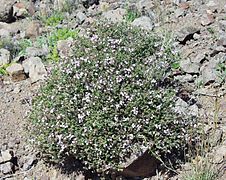Tijm
Nederlandse naam: Tijm
Botanische naam: Thymus vulgaris
Engelse naam: Thyme
Taxonomy ID:
Bron: Wikimedia Commons |
Echte tijm (Thymus vulgaris) is een struikachtige, vaste plant, die behoort tot de lipbloemenfamilie (Lamiaceae). De plant komt van nature voor in het Mediterrane gebied. De soort wordt veel gekweekt en voornamelijk gebruikt als keukenkruid.
De plant wordt 15-20 cm hoog en heeft rechtopstaande takjes. De langwerpige tot lijnvormige bladeren zijn zittend en hebben een sterk omgerolde rand. De onderkant is kort viltig behaard.
Echte tijm bloeit in mei en juni met lila of roze, soms witte bloemen. De bloeiwijze is een schijnkrans.
De vrucht is een vierdelige splitvrucht.
Etherische olie 1- 4% (thymol ca 50%, carvacrol ca 10%), flavonen, loistoffen.
Ademhalingsproblemen, huid, milde desinfectans bij wonden, huidverzorging, spijsvertering, verbetering darmgezondheid.
Bewegingsapparaat | |
Conditie/prestatie | |
Geslachtsapparaat | |
Hart en vaatstelsel | |
Huid- hoeven, klauwen | |
Immuunsysteem | |
Lever | |
Luchtwegen | |
Maagdarmkanaal | |
Ogen | |
Omgeving | |
Oren | |
Pens | |
Uier | |
Urinewegen en blaas |
De etherische oliën van lavendel, basilicum en tijm staan bekend om hun antibacteriële werking (Preuss, Echard, Enig, Brook, & Elliott, 2005), (Hazzit, Baaliouamer, Faleiro, & Miguel, 2006), (Bozin, Mimica-Dukic, Simin, & Anackov, 2006).
Tijm bevat de werkzame stoffen carvacrol en thymol, waarvan bekend is dat ze een antimicrobiële en antioxidatieve werking hebben (Hernandez et al., 2004; Lambert et al., 2001). Voor een direct ondersteunend effect op de darmfunctie is geen recent geen wetenschappelijk onderzoek gedaan.
Voor een stimulerend effect op de eetlust door tijm is in wetenschappelijk onderzoek geen duidelijke aanwijzing te vinden. In een studie waarbij tijm in een concentratie van 1% als additief aan varkensvoer werd toegevoegd, was zelfs sprake van verminderde voeropname (Jugl-Chizzola et al., 2006).
Bronchimax
Cothivet
Cuxarom
Dermiel spray
Digestarom
Kanters Acid Favourit
Porciform Air
RepaXol (olie) (Kemin)
Alle dieren
gevaarlijk voor
Bozin, B., Mimica-Dukic, N., Simin, N., & Anackov, G. 2006. Characterization of the volatile composition of essential oils of some lamiaceae spices and the antimicrobial and antioxidant activities of the entire oils. Journal of Agricultural and Food Chemistry 54, 1822-1828.
Hernandez, F., Madrid, J., Garcia, V., Orengo, J., Megias, M.D. 2004. Influence of two plant extracts on broilers performance digestibility and digestive organ size. Poultry Science 83, 169-174.
Hazzit, M., Baaliouamer, A., Faleiro, M. L., & Miguel, M. G. 2006. Composition of the essential oils of thymus and origanum species from algeria and their antioxidant and antimicrobial activities. Journal of Agricultural and Food Chemistry 54, 6314-6321.
Jugl-Chizzola, M., Ungerhofer, E., Gabler, C., Hagmüller, W., Chizzola, R., Zitterl-Eglseer, K., et al. 2006. Testing of the palatability of thymus vulgaris L. and origanum vulgare L. as flavouring feed additive for weaner pigs on the basis of a choice experiment. Berliner Und Münchener Tierarztliche Wochenschrift, 119, 238-243.
Lambert, R. J. W., P. N. Skandamis, P. J. Coote, and G. J. E. Nychas 2001. A study of the minimum inhibitory concentration and mode of action of oregano essential oil, thymol and carvacrol. Journal of Applied Microbiology 91, 453–462.
Preuss, H. G., Echard, B., Enig, M., Brook, I., & Elliott, T. B. 2005. Minimum inhibitory concentrations of herbal essential oils and monolaurin for gram-positive and gram-negative bacteria. Molecular and Cellular Biochemistry 272, 29-34.
